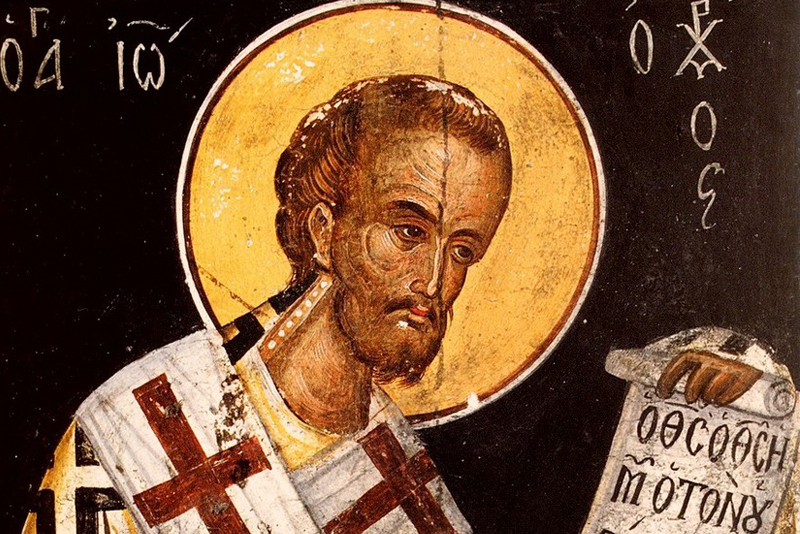
Focus of View and St Paul of Xeropotamou
Nicholas respectfully hung my belt over the back of a chair and closed his eyes. Everyone was having a quiet time. I also lay down on my bed, but I did not feel like sleeping. I looked at the ceiling and tried to focus on the awareness of actually being on Mount Athos. This fact seemed so unreal that I kept thinking of pinching myself all the time during this pilgrimage.
I sat up on the bed. Outside the window was a skilfully constructed cathedral church. It had one, two, three, four… eleven domes! Why eleven? Maybe according to the number of the faithful apostles. The marble church had a carved wooden iconostasis and looked very beautiful. Later I filled the gap in my knowledge about St Paul of Xeropotamou, the founder of this monastery. “The monastery takes its origin in the 10th century, from the son of the Byzantine emperor Michael I Rangabe. St Paul’s worldly name was Procopius. After the Emperor Michael was forced to abdicate and succeeded by Leo V the Armenian, the latter subjected Procopius, still a young boy and a supposed future rival in the right to the throne, to barbaric castration. However, Procopius received an excellent education and, leaving the world at a young age, went to Athos, taking monastic tonsure with the name Paul.
The ascetic life of St Paul attracted many disciples to him, eventually resulting in the appearance of a new monastery. Emperor Romanos, in his royal charter granted to St Paul for the construction of the monastery, calls him the greatest of philosophers.
Princess Maria, daughter of the Serbian ruler Đurađ Branković and wife of Sultan Murad I, presented the monastery with parts of gold, frankincense and myrrh, brought by the Magi as a gift to the Infant Christ and later discovered in the Constantinople treasury of the Greek emperors. According to legend, she was planning to personally bring this treasure to the Monastery and was already approaching its walls when a Divine vision admonished her not to violate the strict Athonite rules, prohibiting women to enter the monasteries of the Holy Mountain. Something similar happened with Princess Galla Placidia in the Vatopedi monastery. At the place where the relics were granted to the Monastery there is a monument (1470) depicting this event in the form of an arch and a gate .
In 1744 the monastery became Greek. The cathedral church was built in 1817-1845 and consecrated in honor of the Presentation of the Lord”.
I looked at the church and imagined myself entering under its vaults after the service and venerating its spiritual treasures. To me, being able to venerate the gifts of the Magi that the Savior Himself has touched is a great miracle. I shifted the focus of my vision from the outside to the inside of the window and saw my newly-washed socks and a T-shirt hanging on the open window frame. Everything depends on where the focus of your view is. In the words of the Gospel, “For where your treasure is, there your heart will be also” (Matthew 6:21).
I was a little worried about Valera finding his way all by himself. I tried to send him a message, but it flew off into the endless air space without finding the addressee. I wrote a few words home. My youngest son was looking forward to daddy’s return from the pilgrimage with gifts and stories. I won’t let him down. I had already prepared for him a knitted cell skufia, similar to a Jewish skullcap, only larger. Next on my list was some Athos lokum with a nut inside, and then I had asked Valera to bring me a pebble from the summit of Athos in case he goes there. I was also going to bring him a slice of bread baked with the use of sourdough, miraculously obtained by the Athonite monks. The leaven, made with only flour, water and salt is brought into the altar for the Liturgy on the feast of the Exaltation of the Cross and on Sunday of the Veneration of the Cross. By the end of the service this mixture rises by itself in a small plate, and then it is used throughout a whole year for leavening and making bread. This bread acquires an especially delicious taste when you are really hungry. It tastes unsavory and austere, like monastic everyday life. This Athonite delight goes remarkably well with Greek salted olives. Of course, it is nothing special, compared to truffles with pineapples, but my son appreciates such simple delicacies. He calls them “bunny bread”.
Translated by The Catalogue of Good Deeds
Part 1
Part 2
Part 3
Part 4
Part 5
Part 6
Part 7
Part 8
Part 9
Part 10
Part 11
Part 12
Part 13
Part 14
Part 15
Part 16
Part 17
Part 18
Part 19
Part 20
Part 21
Part 22
Part 23
Part 24
Part 25
Part 26
Part 27
Part 28
Part 29
Part 30
Part 31
Part 32
Part 33
Part 34
Part 35
Part 36
Part 37
Part 38
Part 39
Part 40




